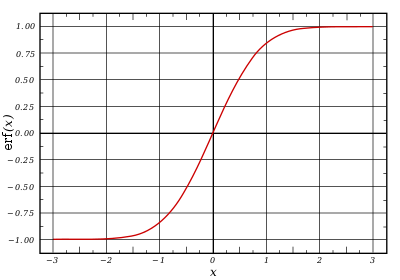In mathematics, the error function (also called the Gauss error function), often denoted by erf, is a function defined as:[1]
| Error function | |
|---|---|
 Plot of the error function over real numbers | |
| General information | |
| General definition | |
| Fields of application | Probability, thermodynamics, digital communications |
| Domain, codomain and image | |
| Domain | |
| Image | |
| Basic features | |
| Parity | Odd |
| Specific features | |
| Root | 0 |
| Derivative | |
| Antiderivative | |
| Series definition | |
| Taylor series | |
The integral here is a complex contour integral which is path-independent because is holomorphic on the whole complex plane . In many applications, the function argument is a real number, in which case the function value is also real.
In some old texts,[2] the error function is defined without the factor of . This nonelementary integral is a sigmoid function that occurs often in probability, statistics, and partial differential equations.
In statistics, for non-negative real values of x, the error function has the following interpretation: for a real random variable Y that is normally distributed with mean 0 and standard deviation , erf x is the probability that Y falls in the range [−x, x].
Two closely related functions are the complementary error function is defined as
and the imaginary error function is defined as
where i is the imaginary unit.
- ^ Andrews, Larry C. (1998). Special functions of mathematics for engineers. SPIE Press. p. 110. ISBN 9780819426161.
- ^ Whittaker, Edmund Taylor; Watson, George Neville (2021). Moll, Victor Hugo (ed.). A Course of Modern Analysis (5th revised ed.). Cambridge University Press. p. 358. ISBN 978-1-316-51893-9.















